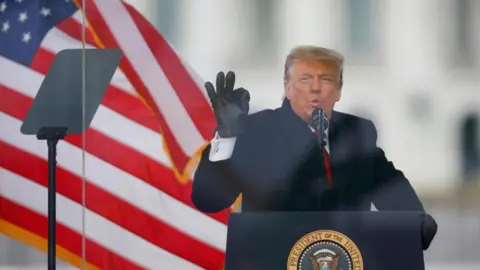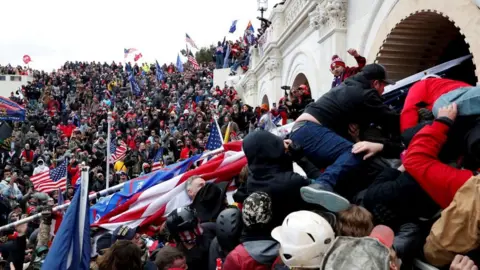Five takeaways from key filing in Trump 2020 election case
 Reuters
ReutersDonald Trump’s alleged criminal efforts to overturn his 2020 US election defeat are described in detail across 165 pages of a new filing from the federal prosecutor investigating him.
The filing, released by a judge on Wednesday, lays out in depth how Special Counsel Jack Smith would pursue his case if it ever comes to trial, which is uncertain. Since Trump is expected to end the prosecution if he returns to the White House, Mr Smith may never be able to make an opening statement or call a witness.
The Supreme Court ruled this summer that Trump cannot be prosecuted for official acts carried out as president, forcing Mr Smith to change the historic case and argue that Trump committed crimes as a private citizen.
Trump denies any wrongdoing in trying to block Joe Biden’s certification as the election winner and his campaign called the document “falsehood-ridden”.
The judge overseeing the case has given Trump’s team until 7 November – two days after the presidential election – to make a response to the latest filing.
Here are five key points detailed in the prosecutor’s arguments and evidence released on Wednesday.
1) Trump planned to claim victory no matter what
“It doesn’t matter if you won or lost the election,” Trump allegedly said at some point after the election. “You still have to fight like hell.”
The filing cites these comments – reported by an unnamed assistant who overheard Trump speaking to his family – as evidence he was trying to overturn the result.
And the document says Trump laid the groundwork for challenging the election even before polling day.
It alleges the Republican had been told that the results would not be known on the day that most Americans voted – but that he might have an early edge before rival Democrats benefited from mail-in voting, which took longer to count.
Because of the Covid-19 pandemic, many voters had voted by mail.
Trump allegedly told advisers that he would “simply declare victory before all the ballots were counted and any winner was projected”.
The former president’s allies were clear on what that meant, according to the filing.
“He’s going to declare victory. That doesn’t mean he’s the winner, he’s just going to say he’s the winner,” a Trump adviser is quoted telling a private gathering of his supporters.
2) He thought others’ fraud claims were ‘crazy’
The filing shows how Trump allegedly carried out his plan to claim victory in several battleground states before votes were fully tallied by spreading false claims of fraud.
Yet he is said to have characterised fraud claims made by some of his allies as unbelievable.
The filing quotes him telling aides that one unnamed lawyer – who appears to be Sidney Powell – was making “crazy” claims, which he likened to sci-fi series Star Trek.
“Nonetheless, the defendant continued to support and publicise” such claims, the document says.
On another occasion, a White House official reportedly told Trump that his personal lawyer, Rudy Giuliani, would not be able to prove his election fraud theories in court.
“The details don’t matter,” he reportedly replied.
3) Pence repeatedly told Trump to move on
The world has seen the deep rift between Pence and Trump that developed after the election. The filing includes new details on supposedly how their relationship deteriorated.
Mr Smith argues that since they interacted as election running mates, Trump’s communication with his vice-president did not count as an official act.
Pence, according to the filing, “gradually and gently” tried to convince Trump to accept the election results, “even if it meant they lost”.
As Trump continued spreading false fraud claims and filing legal challenges, Pence reportedly suggested on 12 November a “face-saving option”: “Don’t concede but recognise the process is over.”
Days later, he encouraged Trump to accept the loss and run again in four years, to which Trump supposedly responded: “I don’t know, 2024 is so far off.”
Eventually, on 1 January 2021, Trump allegedly told Pence that ”hundreds of thousands” of people “are gonna think you’re stupid” for wanting to acknowledge their loss.
Less than a week later, Trump supporters called for Pence to be hanged as they stormed the US Capitol building in the 6 January riot, because he planned to sign off on Biden’s election win. Pence fled to safety in a parking garage.
The filing says that when Trump was informed Pence might be in danger, he allegedly asked: “So what?”
 Reuters/Shannon Stapleton
Reuters/Shannon Stapleton4) Campaign staff created ‘chaos’ during vote count
Mr Smith’s team alleges Trump’s campaign sowed “chaos” in battleground states that risked triggering violence.
When a large batch of ballots in the Democratic stronghold of Detroit, Michigan, seemed to put Biden ahead, a Trump campaign operative allegedly told his colleague to “find a reason” that something was wrong with them.
The colleague then suggested that could cause unrest.
According to the filing, the operative answered: “Make them riot.”
Campaign officials in another swing state, Pennsylvania, allegedly provoked confrontations, which were then used to claim that observers were not given proper legal access to the vote counting.
5) Trump sought to ‘exploit’ the Capitol riot
The prosecutors allege that Trump incited the 6 January Capitol riot by telling a crowd “many of the same lies he had been telling for months”.
In a speech in Washington that morning, Trump “made clear that he expected his supporters to take action”, according to the filing.
Mr Smith has made this allegation before, but he now contends that Trump fired up supporters as a political candidate, not president, and the speech was part of a rally.
His team argues that Trump “directed his supporters to go to the Capitol and suggested he would go with them” to provoke further action.
Then, Trump and his allies allegedly sought to “exploit the violence and chaos at the Capitol” to try to delay the election certification.
Trump watched the riot unfold on Twitter and Fox News, says the filing, citing information from his phone and former White House staff. He also allegedly used social media to target Pence and repeatedly “refused” advisers’ requests to “issue a calming message and make efforts to stop the riot”.

More on US election

North America correspondent Anthony Zurcher makes sense of the race for the White House in his weekly US Election Unspun newsletter.
Readers in the UK can sign up here. Those outside the UK can sign up here.


